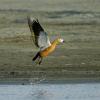Sexes alike. Olive-green above; rust-red fore-crown; buffy-white underbody; dark spot on throat sides, best seen in calling male; long, pointed tail, often held erect; central tail feathers about 5cm longer and pointed in breeding male. One of India’s best-known birds; usually in pairs together; rather common amidst habitation, but keeps to bushes in gardens; remains unseen even when at arm’s length, but very vocal; tail often cocked, carried almost to the back; clambers up into trees more than other related warblers.
- Browse
- Gallery
- Checklists
- Topography
- Glossary
- Bibliography
- Feedback
- About Us










